Download Emulating Mobile Ad-hoc Networks of Hand
Transcript
Emulating Mobile Ad-hoc Networks of Hand-held Devices.
The OCTOPUS Virtual Environment
Fabio D’Aprano
Massimiliano de Leoni
Massimo Mecella
Dipartimento di Informatica e Sistemistica
SAPIENZA - Universita’ di Roma, Sede distaccata di Latina
{daprano,deleoni,mecella}@dis.uniroma1.it
ABSTRACT
providing information to teams and coordinate their intervention to enhance efficiency, by assigning to each teams
specific non-overlapping tasks.
In order to develop and test manet applications for the
front-end, a complete development environment is required.
As part of the development process, it is needed to study
alternatives for design and implementation of software modules, analyze possible trade-offs and verify whether specific
protocols, algorithms and applications actually work. There
exist three way to perform analysis and tests: (i) simulation,
(ii) emulation and (iii) field drills.
Simulation and emulation allow to perform several experiments in a cheaper and more manageable fashion than field
tests. Simulator and emulator (i.e., hardware and/or software components enabling simulation or emulation) do not
exclude each other. Simulation can be used at an earlier
stage: it enables to test algorithms and evaluate their performance before starting actually implementing on real devices.
Simulators, such as NS22 [3], GlomoSim [4] or OMNeT++
[5], allow for several kinds of hardware, through appropriate software modules (such as different device types, like
PDAs or smartphones, or networks, like Ethernet or WLAN
802.11). Even if the application code written on top of simulators can be quickly written and performances easily evaluated, such a code must be throw out and rewritten when
developers want to migrate on real devices.
The emulators’ approach is quite different: during emulation, some software or hardware pieces are not real whereas
others are exactly the ones on actual systems. All emulators (for instance, MS Virtual PC or PDA emulator in MS
Visual Studio .NET) share the same idea: software systems
are not aware about working on an emulated layer (at all
or partially). On the other hand, performance levels can be
worse: operating systems running on Microsoft Virtual PC
work slower than on a real PC with the same characteristics.
Anyway, software running on emulators can be deployed on
actual systems with very few or no changes.
On the basis of such considerations, in order to develop
a complete research environment for manets in emergency
scenarios, we have designed and developed an emulator,
named octopus 3 . Our emulator is intended to emulate
small scale manets (10-20 nodes). Instead of making the
whole manet stack virtual, which would require duplication
of a large amount of code, we decided to emulate only the
Nowadays, Mobile Ad-hoc NETworks (manets) are investigated and adopted in many application scenarios, such as
emergency management. Unfortunately, testing and validating complex systems developed on top of manets is still
a difficult and error-prone task, due to the scarce availability
of virtual environments. In this paper, we present octopus,
a virtual emulation environment for manets, in which designers and developers can create scenarios in large scale
areas including obstacles, defining different movement models, and use real hand-held devices for deploying their software/applications.
Categories and Subject Descriptors
I.6.7 [Simulation and Modeling]: Simulation Support
Systems—Environments
General Terms
Experimentation
Keywords
Mobile Ad Hoc Networks, Emulation, Hand-held Devices,
Wireless, Emergency Management
1. INTRODUCTION
A Mobile Ad-hoc NETwork (manet) is a P2P network
of mobile nodes capable to communicate with each other
without an underlying infrastructure.
In the context of the European project WORKPAD1 , we
are developing a two layer architecture for disaster management [1]. At front-end, different organizations involved in
handling emergency (such as Fire Brigades, Homeland Security, etc.) send to the affected area some teams, each one
arranged in a manet. The back-end layer is in charge of
1
http://www.workpad-project.eu.
Permission to make digital or hard copies of all or part of this work for
personal or classroom use is granted without fee provided that copies are
not made or distributed for pro£t or commercial advantage and that copies
bear this notice and the full citation on the £rst page. To copy otherwise, to
republish, to post on servers or to redistribute to lists, requires prior speci£c
permission and/or a fee.
MobiEval’07, June 11, 2007, San Juan, Puerto Rico, USA.
Copyright 2007 ACM 978-1-59593-762-9/07/0006 ...$5.00.
2
NS2 enables both simulation and emulation. Here, we refer
to NS2’s simulation features.
3
Downloadable at: http://www.dis.uniroma1.it/∼deleoni/Octopus.
At the URL, the reader can also download a user manual.
35
supports and handles possible obstacles, packet losses and
enhanced movement models, like Voronoi [13]. Section 3
goes more in detail about provided functionalities and used
models. Section 4 illustrates the octopus architecture with
some technical details and use experiences. Section 5 concludes the paper, by remarking future developments.
physical MAC layer, leaving the rest of the stack untouched.
octopus keeps a map of virtual areas that users can show
and design by a GUI. Such a GUI enables users to put in
that map virtual nodes and bind each one to a different real
device. Further, users can add possible existing obstacles in
a real scenario: ruins, walls, buildings.
The result is that real devices are unaware of octopus:
they believe to send packets to destinations. Actually, they
are captured by octopus, playing the role of a gateway.
The emulator analyzes the sender and the receiver and takes
into account the distances of corresponding virtual nodes,
the probability of losses as well as obstacles screening direct
view4 . On the basis of such information, it decides whether
to deliver the packet to the receiver.
The advantage of octopus is that, in any moment, programmers can remove it and perform field manet tests without any kind of change. The aim of this paper is to present
octopus and its novel features. Section 2 investigates existing solutions by taking into account several comparing
dimensions, specifically:
2.
RELATED WORK
There exist several mobile emulators in the literature,
even if they do not provide the features which we need for
our intends.
NS2 [3] on its own enables to emulate only wired networks.
Anyway, Magdeburg University has developed a NS2’s patch
to perform wireless emulation [6]. This patched NS2 version
can emulate an arbitrary IEEE 802.11 network by connecting real devices to the emulator machine. This solution actually enables to build applications as if the emulator were
not present and to switch them working between a real environment and an emulated one without any change. Anyway,
it gets some drawbacks: (i) client hosts have to be Linuxbased and, thus, Windows-based computers or PDAs (the
most available ones) cannot be used; (ii) it is needed to
write complex TCL scripts to set up all emulated aspects
of wireless links. So a detailed manet configuration makes
sense when people want to emulate protocols of lower layers
and it is important to consider several physical parameters.
But in the case where we want to test application software
(whose performance and correctness is only slightly affected
by such parameters), we would like to easily configure emulated manets by a GUI so to minimize initial effort. Moreover, (iii) NS2, even patched, does not allow to put possible
obstacles on the map. At the most, people can define some
Voronoi’s paths for node movements to get a similar result,
assuming them to be around obstacles. However, we want
that two virtual nodes are unable to communicate with each
other if they are not in direct sight (e.g., a building is located between them). This is not possible by NS2. Finally,
(iv) possible events during emulation are decided at batch
time in TCL scripts. So, clients cannot affect any change in
nodes topology.
Other emulators, such as MobiEmu [7], MNE [8] MobiNet
[9], EMWIN [10] and NEMAN [11], show similar problems.
EMWIN is one of the few emulators supporting any kind
of devices. It works in a distributed fashion: so-called emulator nodes are real machines and physically attached to
a fast ethernet switch. Emulator nodes can be installed on
whichever platform, PCs or PDAs. Every emulator node
represents a sort of virtual hub where up to 8 Virtual Mobile Nodes (VMNs) can be connected. Therefore, EMWIN
can emulate any platform (PDAs included), even if it does
not handle obstacles, nor it allows to insert new events at
run-time.
JEmu [12] replaces, for each client, the lowest layer of the
communication stack by an emulated one. The emulated
stack sends packets to the JEmu server. It decides, taking
into account certain information (e.g., distance, collision,
etc.) whether the actual destination can receive them (even
if ostacles are not handled). If so, the emulator forwards
these packets to the JEmu client of the receiver. JEmu is
totally written in Java so it works only with Java software.
Furthermore, applications need many changes if emulated
by JEmu.
Table 1 summarizes the features which we are interested
Minimal initial effort. The time amount necessary to
learn and start using the emulator. Several emulators require to write complex scripts to model channels in detail. We are interested in algorithms for the
application layer (and not for the network one), whose
performances are only slightly modified by the channel
and network parameters.
Portability. This feature gets a twofold meaning: from one
hand, it means code to be ported in non-emulated environments with few or no changes. From the other
hand, we refer portability as the ability to enable, during emulation, the use of several platforms, such as
PCs with Linux or Windows and PDAs with Windows
CE or PalmOS.
Handling of Obstacles. The virtual map, which emulator holds, should allow users to insert obstacles representing walls, ruins, buildings. Virtual nodes should
move into the map by passing around without going
over such obstacles. Movements should be as realistic
as possible, according to well-know patterns.
Run-time Event Support. During experiments, destinations of the nodes are required to be defined at runtime, according to the behavior of client applications.
Essentially, movements cannot be defined in a batch
way; conversely, during emulations, nodes have to interactively inform the emulator about the movement
towards given destinations.
As of our knowledge, octopus is the first manet emulator enabling clients to interactively influence changes in the
topology, upon firing of events which were not defined before
the beginning of the emulation. Other emulators require the
specification in batch mode, i.e., when the emulation is not
yet started, of which and when events fire.
In addition, octopus allows to include whichever kind
of device, even PDAs or smartphones, and applications,
whereas other approaches support only some platforms and
applications coded in specific languages. Finally, octopus
4
We assume whenever two nodes are not directly visible,
every packet sent from one node to the other one is dropped.
36
Patched NS2
MobiEmu
MNE
MobiNet
EMWIN
NEMAN
JEMU
Initial effort
High
Low
Medium
Medium
Low
Low
Low
Code needs changes?
No
No
Yes
No
No
No
Yes
Platform
Linux
Linux
Linux
All
All
Linux
All (only Java)
Obstacle handling
Yes (Little)
No
No
No
No
No (but planned)
No
Run-time event support
No
No
No
No
No
No (but planned)
No
Table 1: Summary of features provided by some manet emulators
in for octopus. In this table, “Patched NS2” refers to NS2
enhanced by Madgeburg’s patch. Its “Little” obstacle support means that people might define Voronoi’s paths for
node movements, assuming paths to be around obstacles.
The NEMAN entries referred as “planned” are the features
which authors will implement in future releases: specifically
they plan in future to handle obstacles and to enable applications to influence at run-time links topology.
As you can see from the table, no emulator allows applications to modify at run-time nodes topology. All emulators
are based on the same workflow: at design-time, possibly
through a GUI, users set up the scenario and a virtual map,
binding virtual wireless nodes to real devices, as well as the
moments when events fire, such as reaching a given position.
After, applications are got running on devices to be emulated. When such a preparation phase finishes, emulation
starts and events fire according to the specified schedule.
We want to enable the firing of events which were unforeseen
during the arrangement of emulation scenarios. In the “real
world” the events, such as movements, are caused by users,
which interact with applications on board of devices. In
general, and especially when testing novel prototypes of application software for manets, applications on devices may
influence the link topology and nodes motion. Therefore
batch emulations might be completely useless. Moreover,
obstacles are not handled by other emulators. We think
that these aspects are important to make emulations realistic. So, we introduced such novel features in octopus.
mented as a TCP server listening for special “movement” commands sent by software on board of devices.
We know this breaks our constraint, which states software on devices do not have to be modified when removing emulator. Anyway, changes, if any, are extremely bounded. Basically they consist in “commenting” invocations to octopus. In this case we could not
avoid to violate it: since those events are generated at
run-time by software on devices, only such software
can send those commands. However, if we don’t need
this feature, software on devices actually does not have
to be modified when the emulator is removed.
Packets losses. The emulation system supports userdefined packet loss policies, described by a customizable range based function pd (r). The function
pd (r) = k means the probability of a packet sent by
a node to be delivered to a node r-meters far is k.
Section 3.2 gives more details.
Obstacle-aware mobility model. Two movement models are available in octopus: Way-Point and Voronoi
[13]. The first one assumes nodes to move straight on
the line joining starting and destination point. The
latter is more realistic and it takes into account even
possible obstacles along the path. The devised algorithm is based by the Voronoi plane tessellation model.
Section 3.1 gives more detail about this algorithm.
Broadcast address emulation support. In some algorithms, we may want peers to broadcast a message to
every peer in radio range. Since devices are connected
through a real LAN6 , we cannot use the normal broadcast IP address (i.e., x.x.x.255), as it would send the
packet to all peers in the network without considering the routing table. We want to broadcast only to
virtual neighbors. This issue is resolved by adding a
customizable virtual broadcast address instead of the
usual one.
3. FUNCTIONALITIES AND MODELS
octopus provides functionalities to emulate a wireless local area network by an intuitive and user friendly graphic
interface. Main features provided by octopus are described
as follows:
Integrated graphical scenario editor. Emulation scenario setup is fully managed through a GUI and there
is no need to know or use any scripting language at
all. This choice has been made to allow the average
user, even with only basic network knowledge, to focus
mainly on the experimental aspects.
Node follow feature. Once emulation is started, a node
can move in emulated environment so to “follow” another node. This is intended to study some algorithms in our project, such as disconnection handling
in manets [2]. In octopus, when a node A “follows”
another node B, that means A goes after B when B
moves, keeping at least a fixed minimum distance.
Real time node mobility management. In our target
experiments, destinations that nodes want to reach,
have to be defined at run-time, according to the behavior of client applications. Essentially, movements
cannot be defined in a batch way before emulation
starts; on the contrary, during emulations, nodes have
to somehow inform emulator about their movements
towards a given destination5 . This feature is imple5
In the following, some details of the models implemented
in octopus are provided.
controlled by humans.
6
octopus and other actual devices have to be deployed in
the same LAN in order to have octopus to be able to reach
other devices.
This makes sense when behavior of client applications is
37
3.1 Voronoi Mobility Model
In order to develop a realistic mobility management, the
nodes, living in the emulated environment, move avoiding
obstacles. As a matter of fact, humans follow predefined
paths to reach a place, such as roads and sidewalks: emulated environments should show similar behaviors. octopus
allows to define polygonal obstacles in the virtual map and
it generates the graph of all possible segments of paths that
do not cross them. The algorithm we have devised derives
from Original Voronoi algorithm. Original Voronoi assumes
to have a given set P of points in the plane and builds some
special lines. Voronoi’s lines describe closed polygons in the
plane. Each polygons includes exactly one pi ∈ P of the
original points. For each pi , the corresponding polygon contains all points which are closer to pi than other pj ∈ P .
Since obstacles are polygons and not simply points, a generalization is needed:
1. Generate a “sampled” version of every obstacle by
sampling every side of every obstacle and replacing
each one with a sequence of points. The sampling rate
can be defined by users.
2. Generate Voronoi diagram by considering points generated at point 1.
3. Remove segments crossing one or more obstacles. That
means all segments having at least one of the two vertices inside an obstacle are removed.
Figure 1: An OCTOPUS screenshot.
octopus Voronoi diagram is computed as dual of Delaunay triangulation [14], as it gets actually lower realization
complexity. Each segment generated by the Voronoi algorithm represents a possible part of the path that nodes are
forced to follow in order to move without crossing an obstacle.
physical factors affecting communication distance. Therefore, octopus define communication distance between two
nodes a and b as follow:
3.2 Packet Loss Models
dem
c (a, b)
A probability-based packet loss policy is provided. In real
WLANs, every sent packet may be lost due to the unreliability of the physical channel. In order to provide a realistic emulation, octopus supports a probabilistic approach
to determine whether or not a packet has to be dropped
(so to emulate loosing). In order to let advanced users to
define their own loss function pd (r), we left it opened and
customizable7 .
Since obstacles are present in the virtual area, we assume
radio signal do not pass through obstacles; this means that
each packet sent by a node to another is surely dropped
if the couple of nodes is not in direct sight. In the real
world, a wireless device may measure its distance to the
others by signal to noise ratio (SNR) techniques: the higher
is the physical distance, the higher is the noise in communication channel and, hence, SNR. However, that gives an
approximate “communication distance” between two peers:
this method does not give the exact physical distance for
other factors, such as thin obstacles among devices or other
interferences, which can cause noise incrementing. So, comand real distance dem
may differ.
munication distance dem
c
r
It is too difficult (and perhaps even impossible) to emulate
⎧ em
⎨ dr (a, b) if nodes are in direct sight
∞
if at least one obstacle divides
=
⎩
a and b
The probability to deliver a packet is given by evaluating
the user defined loss function where input is dem
c . So, the
probability to deliver to a node b a packet sent by a node a:
pa,b = pd (dem
c (a, b)) ∈ [0, 1]
When a wants actually to send a packet to b, octopus
computes pa,b . Then, it generates a random value x ∈ [0, 1]
from an uniform distribution. Finally, octopus follows
the rule “if x ≤ pa,b then deliver else drop” to decide
whether such a packet has to be delivered or dropped.
4.
DESIGN OF THE OCTOPUS ARCHITECTURE AND USE EXPERIENCES
octopus is completely written in Java; in particular, it
has been tested to work fine both on Windows and on Linux.
The octopus architecture relies basically on four modules:
Environment Manager. It is the core module and the
octopus’ behavior depends on its setting. Users can
setup several parameters, such as area size, node positions, radio ranges and obstacles. It also computes the
Voronoi’s graph. This module is used by the Gateway
7
For instance, users can model perfect reliability by defining
pd (r) = 1 ∀r ∈ [0, rrange], where rrange is the radio range
of the specific transmission technology, e.g., 100 meters for
IEEE 802.11b/g and 10 meters for Bluetooth.
38
MainWindow
ConfigurationWindow
FunctionWindow
GUI
OctopusServer
0..N OctopusClientThread
Server
GUI
MobileNode
Location
<<Singleton>> Octopus
GatewayManager
SimulationEnvironment
<<Library>> JPCap
FunctionManager
<<Library>> JEP
0..N
0..N
Gateway
Obstacle
0..N
VoronoiGraph
DelaunayTriangulation
DijkstraPathfinder
Environmental Manager
Figure 2: The OCTOPUS’ class diagram
module to get information to learn whether a packet
has to be delivered or not.
by firing manually some events. The gray rectangles
and lines represent, respectively, obstacles and Voronoi
lines, which nodes follow during motions. If a proper
option is active (as it is in the figure), the GUI shows
virtual neighbor nodes by a blue line connecting each
couple of nodes in radio-range. Another option enables
the GUI to design a circle centered in every node to
show the radio range.
Gateway. octopus plays the role of a gateway: this module intercepts all packets sent by nodes involved in
the emulation and addresses every network issue. It
decides whether to forward by taking into account
distance information from the Environment Manager.
The Gateway module implements the packet dropping
policy described in 3.2.
4.1
Implementation Details
Figure 2 shows the classes composing octopus and classifies them with respect to modules described above:
Server. This module implements the TCP Server, listening on the 8888 port. Such a server is intended to
receive command from applications about events (like
movements) to trigger and to reply to queries coming
from clients. For instance, a client could ask which
are neighbors or which is the distance from them. The
communication protocol is a trivial textual protocol.
We have also realized a C# module masking socket
accesses behind an easy API.
Environmental Manager. Octopus
class
is
singleton (i.e., at most one instance may exist)
and derives from the SimulationEnvironment
class.
SimulationEnvironment describes the
physical environment to be emulated and manages also the mobility aspect by VoronoiGraph
class.
SimulationEnvironment class contains a
list of MobileNode, Location and Obstacle instances in order to get a complete environment
description.
Since Delaunay triangulation is
dual of Voronoi but computationally more efficient, a DelaunayTriangulation class is used by
VoronoiGraph class. DijkstraPathFinder class is
used by VoronoiGraph to compute a path from a
source point to a destination.
GUI. In order to minimize the effort to setup initial scenario and bind virtual nodes to the actual devices,
octopus is provided with a Graphical User Interface.
It enables to perform any configuration aspect in a
friendly fashion, without having users to learn any special scripting language. At design-time users can insert
in the virtual area nodes, obstacles and buildings by
“point-and-click”, as in any drawing software. GUI allows users to load/save scenarios and settings from/to
XML files without having to setup every time scenarios from scratch. At run-time, GUI shows the exact
position of virtual nodes in the maps. Figure 1 depicts
an octopus screenshot: the right panel shows the virtual area, whereas the top part is used at design-time
to configure scenarios (nodes, positions, etc.) The left
panel describes the nodes mappings and other information, allowing, also, users to change position of nodes
Gateway. The network level is managed by the
GatewayManager class that uses the JPCap library [15] in order to capture and forward LAN
packets. To evaluate whether a packet has to be
delivered or lost, the GatewayManager is supported by
FunctionManager that makes use of the JEP library
in order to parse a user-defined loss function.
Server & GUI. The octopus TCP/IP server is multithreaded and implemented by the OctopusServer
39
6.
class. It is multi-threaded as it manages multiple connections at the same time: each connection is handled
by a different OctopusClientThread object.
ACKNOWLEDGEMENT
This work has been partly supported by the Italian MIUR
through the FIRB 2001 project MAIS, and by the European
Commission through the FP6-2005-IST-5-034749 project
WORKPAD.
4.2 Use Experiences
In order to verify that the emulator is faithful to manets
being emulated we simply made use of the PING utility:
assuming a certain function pd (r) for packets loss, we experienced actual percentage of replies to ping requests to
deviate from theoretical value at most for 4%8 .
Moreover we have used it to test a Bayesian approach
for disconnection prediction in manets [17]. octopus was
proved to be useful to test such an algorithm. Most of
the devices were PDAs: in experiments they were sending
commands to octopus to instruct it to move corresponding
nodes in the virtual map. Movements took place, according
to unforeseen events, which were caused by run-time interactions among nodes. Besides commenting few lines, this
module is perfectly working on real scenarios.
7.
REFERENCES
[1] T. Catarci, F. De Rosa, M. de Leoni, M. Mecella, S. Dustdar
et al. WORKPAD: 2-Layered Peer-to-Peer for Emergency
Management through Adaptive Processes. In Proc. 2nd
International IEEE Conference on Collaborative Computing:
Networking, Applications and Worksharing (CollaborateCom
2006), 2006
[2] M. de Leoni, F. De Rosa, M. Mecella. MOBIDIS: A Pervasive
Architecture for Emergency Management. In Proc. 4th
International Workshop on Distributed and Mobile
Collaboration (DMC 2006) @ WETICE 2006, 2006.
[3] The Network Simulator – ns-2. http://www.isi.edu/nsnam/ns/
[4] X. Zeng, R. Bagrodia, M. Gerla. GloMoSim: a Library for the
Parallel Network Simulation Environment. In Proc. 12th
Workshop on Parallel and Distributed Systems. 1998.
[5] OMNet++ – Discrete Event Simulation System.
http://www.omnetpp.org/
[6] D. Mahrenholz, S. Ivanov. Real-Time Network Emulation with
ns-2. In Proc. 8th IEEE International Symposium on
Distributed Simulation and Real Time Applications, October
2004.
[7] Y. Zhang, W. Li. An Integrated Environment for Testing
Mobile Ad-Hoc Networks. In Proc. 3th ACM International
Symposium on Mobile Ad Hoc Networking and Computing
(MobiHoc’02), June 2002.
[8] J. P. Macker, W. Chao, J. W. Weston. A low-cost, IP-based
Mobile Network Emulator (MNE). In Proceedings MILCOM
2003 - IEEE Military Communications Conference, 2003.
[9] P. Mahadevan, A. Rodriguez, D. Becker, A. Vahdat. MobiNet:
A Scalable Emulation Infrastructure for Ad hoc and Wireless
Networks. In Proc. 5th International Workshop on Wireless
Traffic Measurements and Modeling, 2005.
[10] P. Zheng, L. M. Ni. EMWIN: Emulating a Mobile Wireless
Network using a Wired Network. In Proc. 5th ACM
International Workshop on Wireless Mobile Multimedia,
2002.
[11] M. Puzar, T. Plagemann. NEMAN: a network emulator for
mobile ad-hoc networks. In Proc. 8th International
Conference on Telecommunications (ConTEL 2005).
[12] J. Flynn, H. Tewari and D. O’Mahony. Jemu: A Real Time
Emulation System for Mobile Ad Hoc Networks. In Proc. of
1st Joint IEI/IEE Symposium on Telecommunications
Systems Research, 2001.
[13] A. Jardosh, E.M. BeldingRoyer, K.C. Almeroth, S. Suri.
Towards Realistic Mobility Models For Mobile Ad hoc
Networks. In Proc. of MobiCom 2003.
[14] L. Guibas, J. Stolfi. Primitives for the Manipulation of General
Subdivisions and the Computation of Voronoi Diagrams. In
ACM Transactions on Graphics, 4:74-123, April 1985
[15] JPcap: Java package for packet capture,
http://netresearch.ics.uci.edu/kfujii/jpcap/doc/
[16] R.J. Punnoose, P.V. Nikitin, D.D. Stancil, D.D. Efficient
simulation of Ricean fading within a packet simulator In 52th
IEEE Vehicular Technology Conference, 2000.
[17] M. de Leoni, M. Mecella, R. Russo A Bayesian Approach for
Disconnection Management. In Proc. Workshop on
Interdisciplinary Aspects of Coordination Applied to
Pervasive Environments: Models and Applications (COMA
2007) @ WETICE 2007, 2007.
5. CONCLUSION AND FUTURE
DEVELOPMENTS
manets are focus of intense research nowadays, due to
their envisioned applicability in highly dynamic scenarios,
such as emergency management. Research on manets has,
up to know, mainly concentrated on the development of appropriate routing protocols, methods for energy preservation, and other issues on the lower four ISO/OSI layers. It is
obvious that virtual environments supporting this research
are more targeted towards low-level issues and details, as
shown in Section 2. But currently, in order to move the research towards the application layer (e.g., for studying adaptive workflow management systems for manets, or contextaware applications, or collaboration miners), the availability
of emulation virtual environments is needed. Such environments should allow to use real devices (including commercial
PDAs) during the emulation, to define virtual maps including obstacles and different movement models, and to have
interaction between the software to be tested and the emulation environments.
Current manet emulators fail in most of these requirements. Conversely octopus, the emulator presented in this
paper, has been designed with these requirements as target. Through a couple of applications and experiments, we
have shown the advantages, for the researchers in the field,
stemming from the availability of octopus.
octopus can be used in every scenario where manet emulation is needed. As the only requirement is an IP network,
it can be even used in robotic planning and in sensor networks. All described features and models have already been
implemented in the version that is downloadable from the
site.
As future work, we plan to enhance the tool, by adding
more movement models. In order to make emulation more
realistic, we plan to model the wireless channel as exactly
as possible. We are investigating on using the Ricean fading
[16]. Moreover, we plan to use extensively octopus as test
bed platform for the European project WORKPAD, which
we are currently involved in.
8
The reader can find more details about the PING experience at
http://www.dis.uniroma1.it/∼deleoni/PingExperience.pdf
40







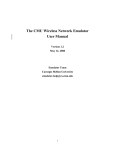

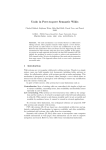
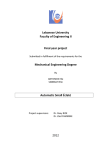
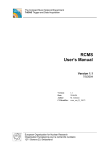
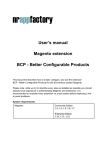

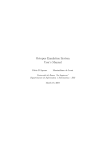
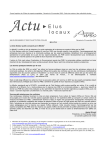
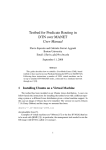
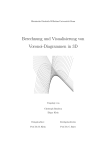
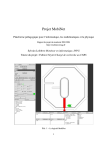

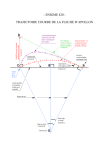

![Octopus` installation and user`s manual [v00]](http://vs1.manualzilla.com/store/data/005962625_1-a588a4c5f54c9235be7780e6e118b681-150x150.png)